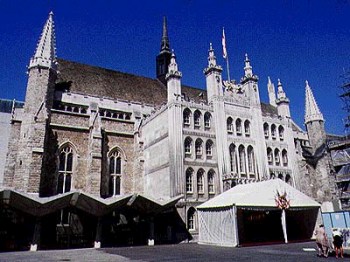Guildhall

For over 800 years the Guildhall in the City of London has been a centre of City government. As the seat of the Corporation of London, the local authority for the Square Mile, it has been the hub of City life from the Middle Ages.
The word "guildhall" is said to derive from the Anglo-Saxon "gild" meaning payment, so it was probably a place where citizens would pay their taxes. The present Guildhall was begun in 1411 and, remarkably, has survived both the Great Fire of London and the Blitz which eradicated so many of London's historic buildings. It is the only secular stone structure dating from before 1666 still standing in the City.
Its origins may be even older as it is thought that at least one earlier Guildhall existed on or near the present site. References to a London Guildhall are made in a document dating back to 1128 and the present Hall's restored west crypt is thought to be part of a late-13th century building. The site of Guildhall was significant even earlier, as indicated by the remains of the long-lost Roman amphitheatre which were discovered in 1987-8 underneath what is now Guildhall Yard. It is possible that Guildhall's Great Hall lies directly over an area of seating which would have had a special box for important Roman dignitaries watching the entertainment.
The part of Guildhall known as the Great Hall is where royalty and state visitors have been entertained down the centuries. As the third largest civic hall in England, it has also been the setting for famous state trials, including that of Lady Jane Grey in 1553. The imposing medieval Hall has stained glass windows and several monuments to national heroes including Admiral Lord Nelson, the Duke of Wellington and Sir Winston Churchill.
The Old Library building housed the Guildhall reference library and the Guildhall Museum from 1873 until 1974 when the collections moved to accommodation in the newly constructed west wing and the Museum of London. Both the Old Library and the adjacent Print Room are now used as reception halls. Beneath Guildhall lie the largest medieval crypts in London.
At the end of the 20th century Guildhall still plays a vital part in the history of the City. This historic building, now with the addition of a modern office complex, is still used as the splendid setting for state and civic banquets in honour of royalty and world leaders. It also provides the venue for the meetings of the Corporation's elected assembly, the Court of Common Council, and for the Honorary Freedom of the City ceremony.
Location
Guildhall
Gresham Street
EC2
Telephone
+44 (0)20 7606 3030.
Getting There
Guildhall is conveniently located in the City of London and is easily reached from St. Paul's, Moorgate, Bank and Mansion House Underground stations and Liverpool Street, Fenchurch Street, Blackfriars, Cannon Street, Moorgate and City Thameslink main line railway stations. The nearest bus routes are to Bank, Moorgate, Cheapside and London Wall and public car parks are available at London Wall, Barbican and Aldersgate Street.
Nearest Tube / Rail Station
St. Paul's
Access
Wheelchair access and disabled toilet facilities.
